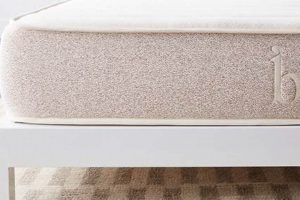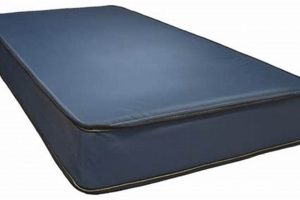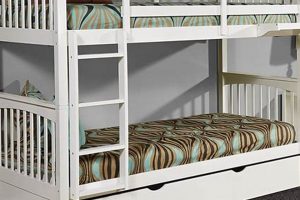A bed dimension exceeding the standard twin length, typically measuring 39 inches wide by 80 inches long, offers additional space for taller individuals. This configuration is frequently found in college dormitories and smaller bedrooms where maximizing floor area is essential. For example, a student exceeding six feet in height would likely find enhanced comfort sleeping on this extended version compared to a traditional twin.
The advantages of this extended length include improved sleep quality due to the reduced likelihood of feet hanging off the edge, contributing to better spinal alignment and overall comfort. Historically, institutions recognized the need to accommodate a growing population with increased average heights, leading to the adoption of this size in settings where standardized bedding is required and space is at a premium. This adaptation demonstrates an understanding of ergonomic needs within space constraints.
The subsequent sections will delve into the specific applications, sourcing options, and factors to consider when selecting bedding and frames appropriate for this particular dimension. Further discussion will address considerations for maintenance, longevity, and impact on overall sleep hygiene when utilizing this particular bed configuration.
Considerations for Utilizing a Long Twin Mattress
The subsequent recommendations aim to provide guidance for selecting, maintaining, and optimizing the use of a long twin mattress. These insights are crucial for maximizing comfort, ensuring longevity, and promoting sound sleep hygiene.
Tip 1: Assess Height Requirements: Before purchasing, accurately measure the height of the intended user. Ideally, the mattress should be at least four inches longer than the individual’s height to allow for comfortable movement and prevent restricted sleeping positions.
Tip 2: Evaluate Frame Compatibility: Ensure the chosen bed frame is specifically designed to accommodate the dimensions. Using an ill-fitting frame can lead to premature wear and tear, reduced support, and potential safety hazards. Verify dimensions precisely prior to purchase.
Tip 3: Invest in Fitted Sheets Designed for Size: Standard twin sheets will not properly fit. Purchase fitted sheets that are specifically labeled for the long twin dimension. This prevents slipping, bunching, and discomfort during sleep.
Tip 4: Consider Mattress Thickness: The mattress thickness should be chosen based on individual preferences and needs, but also accounting for frame height. A thicker mattress may require a lower bed frame to ensure ease of getting in and out of bed, especially for individuals with mobility considerations.
Tip 5: Rotate the Mattress Regularly: To promote even wear and prevent sagging, rotate the mattress every three to six months. This will help distribute weight evenly across the surface and extend its lifespan.
Tip 6: Protect Against Stains and Allergens: Utilize a mattress protector specifically designed for the size to safeguard against spills, stains, and allergens. This is particularly important in shared living spaces or for individuals with allergies.
Tip 7: Research Mattress Material Options: Different mattress materials, such as memory foam, innerspring, or latex, offer varying levels of support and comfort. Investigate the characteristics of each material to determine the best option for individual sleep preferences and any specific orthopedic needs.
These guidelines emphasize the significance of careful planning and informed decisions when incorporating a long twin mattress into a sleep environment. By adhering to these considerations, individuals can maximize comfort, ensure the longevity of the mattress, and promote restful sleep.
The concluding sections will summarize the overall advantages and limitations, providing a comprehensive overview of this specific mattress size and its suitability for various applications.
1. Length
The dimension of 80 inches defining the length is the critical characteristic differentiating an “extra long twin mattress size” from a standard twin. This extended length provides significant advantages in specific scenarios, directly impacting user comfort and overall suitability.
- Accommodating Taller Individuals
The primary purpose of the 80-inch length is to comfortably accommodate individuals exceeding average height. A standard twin mattress may leave taller individuals with their feet dangling off the edge, leading to discomfort and disrupted sleep. The extra length ensures adequate support from head to toe, promoting proper spinal alignment.
- Dormitory Standardization
Many colleges and universities utilize “extra long twin mattress size” as a standard in dormitory rooms. This standardization allows the institution to cater to a diverse student population with varying heights while efficiently managing bedding inventory and room layouts. It minimizes the need for specialized bedding solutions for individual students.
- Enhanced Comfort and Sleep Quality
The added length contributes to improved sleep quality by allowing occupants to stretch out fully and move freely without restriction. This reduces the likelihood of positional adjustments throughout the night, which can interrupt sleep cycles. The resulting increase in sleep quality can lead to improved cognitive function and overall well-being.
- Impact on Bedding Requirements
The specific length necessitates the use of appropriately sized bedding. Standard twin sheets and blankets will not adequately fit an “extra long twin mattress size.” Individuals must purchase bedding specifically labeled as ‘Twin XL’ or ‘Extra Long Twin’ to ensure a proper fit and avoid issues such as sheets slipping off or blankets failing to cover the entire mattress. This is a crucial consideration for budgeting and planning.
In summary, the 80-inch length is the defining attribute that dictates the purpose and applicability of an “extra long twin mattress size.” It directly influences user comfort, institutional standardization practices, and bedding procurement decisions, demonstrating its central role in the overall product profile.
2. Width
The 39-inch width is a constant parameter within the context of an “extra long twin mattress size,” defining its lateral dimension. This fixed width influences spatial considerations, occupancy suitability, and practical applications in various settings.
- Space Optimization in Confined Areas
The standardized 39-inch width contributes to efficient space utilization, particularly in environments such as dormitories, small apartments, or shared bedrooms. This dimension allows for multiple beds to be arranged within a room without excessively compromising available floor space. Strat
egic room layout is thereby facilitated by the fixed width. - Individual Occupancy Suitability
The width provides sufficient sleeping space for a single adult or child. While narrower than a full-size mattress, the 39 inches offer adequate room for comfortable sleep without being excessively wide, which could be impractical in smaller rooms. This balance between comfort and spatial efficiency is a key feature.
- Bed Frame and Accessory Compatibility
The consistent width allows for standardized bed frame designs. Bed frames specifically designed for “extra long twin mattress size” are manufactured with a corresponding width to ensure a secure and proper fit. Similarly, accessories such as bed risers, headboards, and bed rails are designed with this dimension in mind, simplifying the selection and installation process.
- Weight Distribution and Support Characteristics
While the length caters to taller individuals, the 39-inch width affects weight distribution and overall support. Mattress manufacturers must account for this width when designing the internal support structure, ensuring uniform support across the sleeping surface. This is especially important for mattresses with zoned support systems.
The 39-inch width, therefore, represents a fixed yet critical element of the “extra long twin mattress size,” playing a defining role in spatial efficiency, individual comfort, frame compatibility, and structural support. Its standardization contributes to the practical advantages and targeted applications of this specific mattress configuration.
3. Dorm Room Standard
The prevalence of “extra long twin mattress size” in college and university dormitories is a direct consequence of the need to accommodate a diverse student population with varying heights within space-constrained environments. The standardized implementation of this size mitigates the logistical complexities associated with providing different mattress sizes to individual students. The “Dorm Room Standard” designation is, therefore, a critical component of understanding the market presence and practical application of this mattress dimension. For example, institutions such as large state universities with thousands of residential students almost universally equip their dorm rooms with beds of this specific size to ensure uniformity and cost-effectiveness.
The benefits of adhering to this standard extend beyond mere logistical convenience. It simplifies the process of purchasing and distributing bedding, reducing administrative overhead and minimizing potential errors. Furthermore, it ensures equitable allocation of resources, preventing discrepancies in accommodation based on student height. The standardized dimension also allows third-party vendors to supply pre-packaged bedding kits specifically tailored to meet the needs of incoming students, streamlining the move-in process and enhancing student satisfaction. This ecosystem reinforces the “Dorm Room Standard” as a practical necessity.
Challenges associated with this standardization primarily involve situations where students require specialized bedding solutions due to specific medical conditions or preferences. However, these instances are typically addressed on a case-by-case basis, with institutions offering reasonable accommodations when necessary. In conclusion, the inherent link between “Dorm Room Standard” and the widespread adoption of “extra long twin mattress size” underscores the practical significance of standardization in managing large-scale residential environments, optimizing resource allocation, and ensuring a degree of uniformity within a diverse student population.
4. Taller Individuals
The dimension of the “extra long twin mattress size” directly addresses the needs of taller individuals, who often experience discomfort and inadequate support on standard-length mattresses. This specific configuration prioritizes ergonomic accommodation and promotes improved sleep quality for this demographic.
- Ergonomic Accommodation
The 80-inch length of an “extra long twin mattress size” provides necessary extension to fully support the body of taller individuals, typically those exceeding six feet. This prevents limbs from hanging off the edge of the mattress, which can cause discomfort, restrict circulation, and disrupt sleep patterns. Adequate support is fundamental for spinal alignment and overall sleep quality.
- Reduced Sleep Disruption
Taller individuals using standard twin mattresses often experience frequent positional adjustments during sleep as they attempt to find a comfortable posture. This restless movement disrupts sleep cycles, leading to reduced restorative sleep. The increased length of an “extra long twin mattress size” minimizes the need for these adjustments, facilitating more continuous and restful sleep.
- Enhanced Spinal Alignment
Proper spinal alignment during sleep is crucial for preventing back pain and promoting long-term musculoskeletal health. Standard mattresses may force taller individuals into compromised sleeping positions, contributing to spinal misalignment. The added length of this mattress size allows the spine to maintain a more natural and supported posture throughout the night.
- Psychological Comfort and Well-being
Beyond physical considerations, adequate bed length contributes to a sense of psychological comfort and well-being. Knowing that the bed provides ample space and support reduces anxiety and fosters a feeling of relaxation, creating a more conducive environment for sleep. This psychological aspect should not be underestimated in the overall assessment of sleep quality.
In conclusion, the relationship between “taller individuals” and the “extra long twin mattress size” is rooted in ergonomic necessity and its resultant impact on sleep quality. The longer mattress is not merely a matter of convenience, but rather a functional solution for addressing specific physiological needs, leading to improved comfort, spinal health, and psychological well-being.
5. Space Optimization
In environments where square footage is a premium, the “extra long twin mattress size” serves as a strategic solution for space optimization. Its dimensions provide a balance between accommodating individual comfort and minimizing the footprint within a room, rendering it particularly suitable for shared living spaces and compact dwellings.
- Efficient Room Layouts
The relatively narrow width of an extra-long twin mattress, typically 39 inches, enables flexible room configurations. Multiple beds can be arranged side-by-side with minimal wasted space between them, as commonly seen in dormitories and barracks. This allows for the inclusion of other essential furniture pieces without overcrowding the room. The narrow dimension directly influences the overall layout of the room.
- Maximizing Floor Area
By providing adequate sleeping length without excessive width, the dimensions minimize the amount of floor area consumed by each b
ed. This is particularly advantageous in small apartments or studio spaces where every square inch of available floor space is critical. This efficient use of floor space contributes to a more open and functional living environment. - Vertical Space Utilization
The dimensions facilitate the use of vertical space through bunk bed or loft bed configurations. The standardized dimensions simplify the construction and compatibility of these arrangements, further optimizing floor space. Bunk beds are frequently employed in childrens rooms and guest rooms to maximize occupancy without compromising the overall footprint.
- Furniture Integration
The dimensions allow for the integration of under-bed storage solutions. Drawers, storage bins, or even trundle beds can be efficiently incorporated beneath an extra-long twin mattress, providing additional storage space without expanding the beds footprint. This integration contributes to a more organized and clutter-free living environment. Bed frames designed for this size frequently offer built-in storage options.
The efficient space utilization facilitated by the “extra long twin mattress size” makes it a practical choice for environments where maximizing floor space is paramount. Its standardized dimensions enable flexible room layouts, optimized vertical space utilization, and integration of storage solutions, contributing to a more functional and organized living environment. These aspects are fundamental to its widespread adoption in settings where space is a critical factor.
6. Sheet Availability
The issue of sheet availability is intrinsically linked to the practicality and user satisfaction associated with the “extra long twin mattress size.” This aspect directly influences the convenience and cost-effectiveness of ownership, representing a key consideration for potential purchasers. Securing properly fitting sheets is essential for comfort and hygiene.
- Specialized Sizing Requirements
Standard twin sheets are not compatible with an “extra long twin mattress size.” The increased length necessitates the use of sheets specifically labeled as “Twin XL” or “Extra Long Twin.” Failure to use correctly sized sheets results in improper fit, potential sheet slippage, and reduced comfort during sleep. Retailers clearly specify these designations on product packaging.
- Retailer Stock Levels and Variety
While “Twin XL” sheet sets are widely available, the variety of materials, patterns, and thread counts may be less extensive compared to standard twin or full-size sheets. Major retailers typically offer a selection of “Twin XL” sheets, but niche or specialized options may require online sourcing. Stock levels can fluctuate depending on the time of year and promotional periods.
- Cost Considerations
The cost of “Twin XL” sheet sets may be marginally higher than standard twin sheets due to lower production volumes and specialized demand. This cost differential, while often minor, should be factored into the overall budget when considering the purchase of an “extra long twin mattress size.” Comparison shopping across various retailers is advisable.
- Institutional Procurement Practices
Colleges and universities that utilize the “extra long twin mattress size” as a standard often offer bedding packages specifically designed to fit these mattresses. These packages provide a convenient and cost-effective solution for students, eliminating the need to source sheets independently. Institutions leverage bulk purchasing power to secure favorable pricing on appropriately sized sheets.
The accessibility and affordability of correctly sized sheets constitute a critical component of the user experience. The increased availability of “Twin XL” sheet sets across various retailers has mitigated some of the challenges associated with sourcing appropriate bedding. However, consumers should remain mindful of the specific sizing requirements and cost implications when making purchasing decisions, whether for individual use or institutional applications. The compatibility with readily available and appropriately sized sheets adds considerably to the long-term practicality of an “extra long twin mattress size.”
Frequently Asked Questions about Extra Long Twin Mattress Size
The following section addresses common inquiries and clarifies misconceptions pertaining to the dimensions, applications, and suitability of extra long twin mattresses.
Question 1: What distinguishes an extra long twin mattress size from a standard twin mattress?
The primary difference lies in the length. An extra long twin measures 80 inches, while a standard twin measures approximately 75 inches. The width, typically 39 inches, remains consistent between both sizes.
Question 2: Are standard twin sheets compatible with an extra long twin mattress?
No. Standard twin sheets are designed for mattresses measuring 75 inches in length and will not adequately fit an 80-inch extra long twin mattress. Dedicated “Twin XL” or “Extra Long Twin” sheets are required.
Question 3: What is the intended demographic for an extra long twin mattress size?
The primary target demographic comprises taller individuals, typically those exceeding six feet in height, who require additional legroom for comfortable sleep. These mattresses are also prevalent in college dormitories.
Question 4: Can an extra long twin mattress be used on a standard twin bed frame?
No. Bed frames must be specifically designed to accommodate the 80-inch length of an extra long twin mattress. Using a shorter frame will result in inadequate support and potential damage to the mattress.
Question 5: Where can one purchase bedding specifically designed for an extra long twin mattress size?
Bedding labeled as “Twin XL” or “Extra Long Twin” is available at major retailers, both online and in brick-and-mortar stores. Specialty bedding retailers also offer a selection of appropriately sized sheets and blankets.
Question 6: Does the increased length of an extra long twin mattress impact its weight-bearing capacity?
The weight-bearing capacity is primarily determined by the internal construction and materials of the mattress, rather than solely its length. Consult the manufacturer’s specifications for weight limits, regardless of the dimensions.
These responses aim to provide clarity regarding the key attributes and considerations associated with extra long twin mattresses. Understanding these aspects facilitates informed decision-making for potential purchasers.
The subsequent section will explore practical tips for maintaining and prolonging the lifespan of an extra long twin mattress, ensuring optimal value and continued comfort.
Conclusion
This exploration of the “extra long twin mattress size” has illuminated its key characteristics, benefits, and applications. Its unique dimensions address the needs of taller individuals and contribute to space optimization, especially within standardized environments like college dormitories. Understanding the implications of its dimensions, particularly concerning bedding availability and bed frame compatibility, enables informed purchasing decisions.
The selection of appropriate bedding remains a critical aspect of ownership. Prioritizing quality and assessing individual needs will maximize the
long-term benefits of using this specific mattress dimension. Further research into mattress materials and construction will enhance the overall sleep experience and promote a greater understanding of sleep hygiene.





![Best Walmart Twin Size Blow Up Mattress [Guide] Organic & Natural Mattress Buyer’s Guide: Non-Toxic Sleep Solutions Best Walmart Twin Size Blow Up Mattress [Guide] | Organic & Natural Mattress Buyer’s Guide: Non-Toxic Sleep Solutions](https://mattressworldpa.com/wp-content/uploads/2025/07/th-5075-300x200.jpg)

